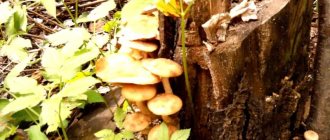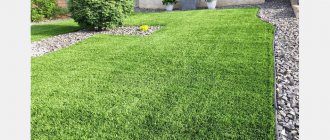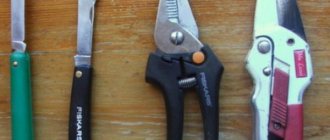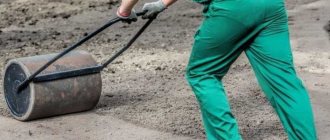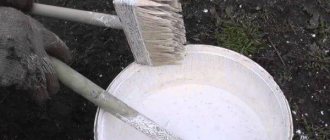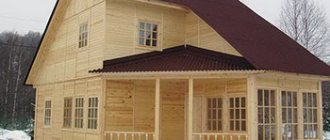How to remove a stump using mechanical methods
It is necessary to uproot stumps in suburban areas if:
- You have purchased a plot of land on which old trees grow, and you want to either replace them with young ones or redevelop everything on the plot.
- An old tree has been knocked down by the wind, or it is in disrepair.
- Because of a stump or tree, it is impossible to create the landscape composition conceived by the owner of the site, or they interfere with planting a vegetable garden or planning the local area.
In order to remove a stump mechanically, it is advisable to use gas-powered tools or rent special equipment. Renting equipment is too expensive, since in this case an organization that has the appropriate equipment is involved in the work.
Do-it-yourself uprooting
So we have come to the most important method for us, since on our own site we are used to doing everything with our own hands. You can also uproot stumps yourself, but this method is also not the best, and therefore we will consider its advantages and disadvantages separately.
Advantages of the method
- Manual removal of stumps is carried out absolutely anywhere on your site, which is very good, because not all objects can be approached with a crusher and, especially, with a tractor;
- With a skillful approach, manually uprooting stumps is a fairly effective method, since you can remove not only the outer part from the soil, but also the absolute maximum of the root system;
- After clearing a piece of land from a stump, the next year it is ready for cultivation.
Disadvantages of the method
- First of all, this is really hard, and sometimes even hellish, physical work;
- This method cannot be used in winter, since its effectiveness is completely lost due to the significant complication of the work - snow, frozen soil, mud, and so on;
- The cost of such uprooting from companies is now almost impossible, and if so, it will cost you a fortune, especially if the tree was tall and old, and had a serious root system.
Manual uprooting of stumps is used everywhere, and every experienced summer resident has encountered it more than once. It happens in approximately the same way in any region of our country, and the whole world as a whole.
For work you will need a crowbar, shovels, axes, hammers, levers, possibly winches, as well as cutting tools and, of course, gloves and plastic glasses for your own protection.
The stump is dug in from all sides to a certain depth, usually a couple of tens of centimeters. Next, its main roots are separated from the rest of the trunk and, with the help of levers or the hefty force of the participants in the process, the stump is removed from the soil.
Removing a stump with a chainsaw
The simplicity of this method is obvious and accessible to everyone. The stump must be cut down to ground level with a chainsaw. If you decide to hire a sawyer to fell your tree, he or she can cut down the stump. However, using this method is not advisable if your plans do not include creating a vegetable garden or flower bed in place of the cut tree.
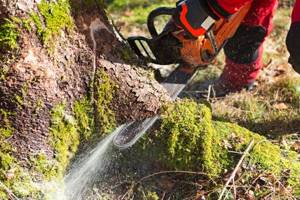
We remove the old stump using a chainsaw.
Cutting down a stump to ground level with a chainsaw is an easy way to get rid of it, but it is only used on lawns or areas of the garden where landscaping work is not planned and the remains of the stump remaining in the ground will not bother you.
Stump removal using heavy equipment
uproot stumps using a hired tractor, bulldozer or excavator. But this requires access to the site and a place where it will be convenient for the equipment to work. This method is used when clearing an area for construction, when several stumps are uprooted. Heavy equipment damages the top layer of soil, so using this method is not possible if you need to preserve your lawn or fruit trees.
The use of heavy equipment is necessary when it is necessary to first clear the area of roots and stumps before starting construction and planning work.
How to uproot a stump, alternative methods
- What is the easiest way to uproot a stump without using chemicals?
An alternative method to chemistry, but based on the same principle, can be considered the forced planting of a stump with mycelium (spores) of edible mushrooms, i.e. we make mycelium at our removal facility. You should not immediately criticize this method. He also has the right to life. The fact is that the vital activity of these organisms is capable of destroying the stump without any mechanical intervention. All you have to do is come up with new recipes for preparing dishes from your own mushrooms, since they will please you for quite a long time, about 5 years. But this is an almost waste-free production: there will be no stump, and you can always pick fresh mushrooms for dinner.
Removing a Stump with a Stump Grinder
This method has many positive aspects, among which the main ones are that the normal condition of the lawn is maintained, and a large area will not be required to work with a forestry cutter. The stump is milled to a great depth - approximately 30 cm below ground level. However, the cost of a stump cutter is high, so it makes no sense to purchase it to remove one stump.
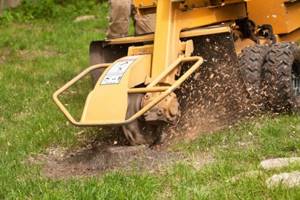
Using industrial methods to remove tree roots.
To remove one stump, you can use a mini-tractor and a crusher. In this way, you can get rid of a stump that is located behind healthy trees, the roots of which will remain intact.
There are a lot of offers on this topic on the market for services that offer stump removal, so it’s easy to find a specialist who works as a forestry cutter.
TOP 5 mechanical ways to get rid of a stump
We offer five proven methods that will help you say goodbye to the “undesirable resident” of your site as quickly as possible.
- Manual digging is time consuming but effective. The very first method is really to highlight manual digging, since this is the first thought that appears to gardeners. The technology is simple - you dig as deep as possible around the perimeter of the stump, getting close to the root system. All roots that are encountered along the way need to be cut, in this way the stump can be pulled out. Of course, this process is very labor-intensive and requires a lot of strength, time and patience. But it is impossible to say that the technique is unrealistic. The main thing is that after removing the stump from the ground, try to pull out large parts of the root, which will be able to produce young shoots in the future, which is very undesirable, since all the work is in vain. It is easier to work in a team of 2-3 people, then the process will go faster and more fun. From materials and tools you will need all the protective elements, as well as all kinds of hand tools that will help you dig, saw and pull out.
- Use a chainsaw for uprooting. It’s more effective and quick to use a chainsaw to clean the stump. This method is relatively fast. The point is to cut down the stump as low as possible, preferably below ground level, so you will have to dig a deep hole around the perimeter. When you reach the roots, start cutting as low as possible. Next, the resulting hole should be filled with as much earth as possible. The stump is as if it never happened. In principle, everything is simple, but there are nuances. If the stump has a viable root, then young shoots may emerge in the future. But experts believe that if the stump was really very old, then everything will be successful, and in that place it will be possible to plant vegetable crops with ground fruiting.
- Removing a stump using a tractor. Of course, this technique is very simple, but not available to everyone. A tractor is a quick way to dig a hole and also pull out a deep-seated stump. It is possible that you will need to use a manual method of root control, but in the end this method is much simpler. Among the obvious disadvantages of this method are several important factors. The first thing is where to get a tractor, because not everyone has such equipment on their farm, and hiring is not a budget option, although it is less troublesome. And secondly, the location of the stump should be objectively assessed, because there must be enough space for a large tractor so that it can not only work productively, but also not harm the “neighboring crops.”
- Fighting a stump with a specialized machine or the operating principle of a stump crushing machine. Since the problem of the presence of old stumps is very urgent, specialist scientists have specially created a special technique that could transform the tree into very small particles - rot. This miracle for gardeners is called a stump crusher. The principle of operation is first-class, since the grinding occurs not only of the stump itself, but also of the root system. For full-fledged work, the equipment should be deepened into the soil by 30 cm. It is very simple and easy to use this machine. The main advantage will be its practicality, because it qualitatively helps to overcome the problem, but at the same time without causing any harm to nearby plants of any size. Naturally, this is the best option, but the downside is the cost. It is difficult to accurately formulate the price, although it is known that for an ordinary garden plot and rare use, the costs are not reasonable. The solution is to hire guys who can uproot your stump with this particular machine without damaging the rest of the plants on the site. This procedure will clearly be cheaper than buying such a miracle of technology.
- Fighting a stump with an excavator. This method works great, but in addition to the good moments, nuances emerge. An excavator is not a small machine that can overcome a stump of any size and dimensions. But there are many aspects that are not only confusing, but also alarming. Firstly, there must be enough space on your territory so that such large equipment can not only reach its destination, but also not disturb the landscaping. Secondly, you should be clearly aware that this procedure cannot be completed completely painlessly. Even if you have enough space, the equipment will sink into the soil, since it is very large, thus the top ball will be completely damaged, which will certainly negatively affect the further growth of plants. Conclusion, an excavator is a good option, but it should be used in cases where it will be safe for the site itself, for example, at the start of landscaping the area.
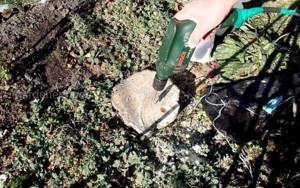
Manual methods of uprooting stumps
You can uproot stumps manually using an ax, shovel, hacksaw, cable and winch. This method will not require any material costs from you. You will only waste time and energy, especially when uprooting a large stump. Therefore, before doing the work, you need to think: is it worth doing it manually?
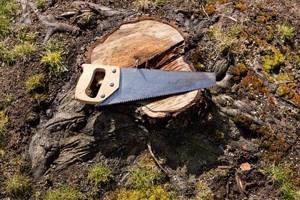
Manual methods for removing old tree stumps.
Using a shovel, ax and hacksaw
The stump is first examined to identify the thickest roots, which are dug up and cut using an ax or hacksaw. After this, dig the stump to a depth of at least half a meter and pull it out using a winch. This method is good for getting rid of tall stumps, since the rest of the trunk acts as a lever when turning the stump out.
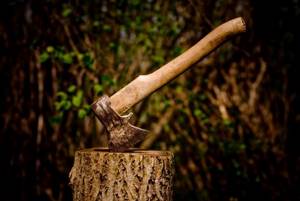
Removing old tree stumps from a summer cottage.
Before removing the stump, it is necessary to pre-treat the roots - dig up large roots, cut them with a hacksaw or remove them with an ax. When the roots are separated and the cable is secured, the stump is prepared for uprooting. If the stump is small, it can be easily removed with a winch using a cable.
A garden shredder is used to remove old grass and dry fallen branches from a summer cottage. Thanks to it, it will not be difficult to clean the garden area in spring or autumn.
Plot
-31 vote
+
Vote for!
—
Vote against!
Cold winters, parasites and various diseases cause great damage to trees, which lead to the withering of plants and their further removal from the plots. After cutting down the trees, you need to think about what to do next with the stump. One of the most successful methods that you can use is to simply fit the stump into the design of the area where it is located. A wooden stump fits under the table, and you can also make a flower bed out of it. But very often it simply needs to be removed, which is why it is useful to know how to uproot a stump without effort.
- Using a winch
- Potassium nitrate
Mechanized methods for uprooting stumps
There are three ways to remove stumps: manual, mechanical and chemical. Thus, to get rid of a tree stump, they use their physical efforts, chemicals and specific equipment. The easiest way to uproot a stump on a site is with the help of special equipment - this way you will spend a minimum of your effort.
Earthmoving equipment
Stumps are uprooted using bulldozers, excavators, manipulators, and truck cranes. This method is reliable and can be completed in a short period of time. If you are interested in how to uproot a large stump, then this method is most suitable; it will cope with any stump.
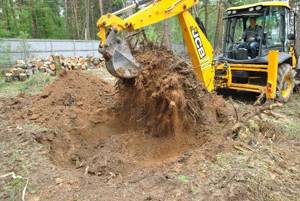
However, it is worth noting that this technique is expensive. The disadvantage is the difficulty of access to the work site if the site is small. The size of the car is usually large, and the area is landscaped - planted with flowers, beds, fruit and berry bushes. It is also impossible to simply tie a rope around the root and pull it out. After all, this requires a heavy tractor on tracks.
Among other things, such self-propelled guns are quite destructive to the soil, so if there is a lawn on the personal territory, it will certainly collapse. From this we can conclude that uprooting stumps in this way will only work on a site intended for development. In this case, you will not worry about flower beds, and there will be no difficulties with maneuvering the machine.
Stump grinder
Uprooting stumps in this way is carried out using a special hand tool. It is called a stump grinder or cutter. This tool is much smaller than any wood chip removal machine, so it is universal and can be used on any site.
The size of the device itself is similar to the dimensions of a garden wheelbarrow. The device rises quite easily, that is, there will be no difficulties when moving it to the tree. The problem exists, but it’s different: there are very few such instruments on the domestic market due to their high cost. But still, in our market there are quite a lot of different organizations that have such equipment and are engaged in uprooting stumps.
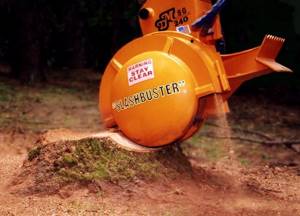
The work of stump grinding involves milling it. To put it in a simpler way, how to uproot a stump on a property using a chopper, then this tool crushes the stump layer by layer into small chips. It also crushes the underground part to a depth of 30 cm. Therefore, it is possible to immediately occupy the territory where the stump was located for a flowerbed or vegetable garden.
Manual methods for uprooting stumps
When removing a stump manually, physical effort alone will not be enough; you should take care of the availability of available tools - a winch, an ax, a crowbar.
Using a winch
The very specificity of using a winch is more effective than other methods, that is, it copes with fairly high stumps. Therefore, in order to apply this method, it is recommended to leave the height of the stump at one meter. Of course, you don’t have to do this, but this will make your work easier. The disadvantage of this method is that the winch may not be able to support a large old tree.

To uproot a stump, in addition to a winch with a force of three tons or more, you will need auxiliary means: a rope, a shovel, an ax and a lever. The first thing that is done is digging up the stump at a distance of up to 1.5 meters, followed by deepening until you see the roots. The roots are removed using a hacksaw or an ax.
After this, the winch is attached to the base of a nearby tree or pole, from which you can easily reach the stump to be uprooted. The cable is securely attached to the stump that you will be uprooting, after which a wooden stump is placed under it on the winch side. Then we take up the winch. After this procedure, the stump should come out of the ground along with the roots.
Using a crowbar and an ax
This method is difficult and poorly effective, suitable for stumps with a small diameter. To begin with, a trench is dug around the stump, this is done to expose the roots. Next, we cut off the roots and slip a crowbar under the stump, after which we tear it out.
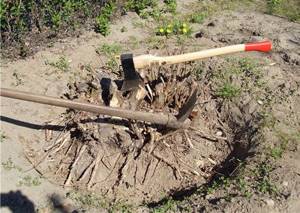
The technique is effective with stumps with a diameter of up to 20 cm. If the stumps are larger in diameter, it is necessary to dig a huge pit around the stump, while cutting off the roots. This activity can last up to two days. Thus, the easiest way is to cut down the stump well below ground level, and chop up whatever remains with an ax. And after this procedure, we fill the hole with earth.
Chemical methods for removing stumps
The method using chemicals on stumps of any size works flawlessly, but for full results it will take a lot of time - up to three years.
Potassium nitrate
The most common method is to cut the stump as low as possible, and then, during the thaw in the cold season, drill holes in it with a depth of up to 40 cm and a diameter of up to 7 cm. Next, potassium nitrate is poured into the stump. Usually the calculation goes like this: one hole is made per 10-12 cm in diameter. After this, the hole is filled with water, saltpeter is compacted and then the stump is covered with polyethylene on top. It is left in this form throughout the winter.

We recommend using a concentrated solution, which must be added over several days. This will help speed up the absorption of nitrate into the wood of the stump. The meaning of all this is this: when heated, saltpeter releases oxygen, and dried wood burns out easily and quickly when ignited.
After this treatment, the stumps are easily burned in the spring. This is done as follows: gasoline is poured into the hole of the stump, it is set on fire, and after the stump is completely burned out, the place under the stump is dug up. But this method is not acceptable on peat lands, because it can cause underground peat to burn.
Use of urea
If you are still looking for a way to remove a stump without uprooting it, then take advantage of the properties of urea to decompose wood. The technology of this method is similar to that of using nitrate; a hole is also drilled into which urea is poured. After this, we wrap the stump tightly with cellophane. In a year there will be nothing left of this stump; there is no need to even burn it.
Use of salt
The next option is to sprinkle coarse salt on the stump. After some time, it will become saturated with salt and will undergo destruction - it will simply turn into dust. This method is suitable only if there are plans to build on this site. After all, salt also destroys the soil near the stump, that is, there will be no harvest in this area.

Flooding with water
To apply this method, you need to dig a hole near the roots of the tree at a distance of half a meter. Next, use a good stream of water to wash the root system off the ground. After this procedure, a “hanging” stump is obtained. After all the water has drained into the hole, we leave the root system to dry. After drying, usually the next day, we chop all the roots of the stump, then remove the root itself.
Growing mushrooms
There is another effective and useful way to uproot a stump; more precisely, in this case you won’t have to uproot anything. We make holes in the cut of the stump and fill the mycelium there. Water it and cover it with film. In this way you sow a stump with oyster mushrooms or honey mushrooms. We arrange mushroom caps on the surface. Then after two hours we shake it, this releases the spores. Next, mix them with water and water the unnecessary stump. The harvest will be in a year. But this method also has a disadvantage: there is a high risk that nearby trees may become infected with fungal spores.
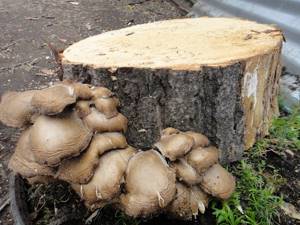
Thus, uprooting stumps is useful in preparing the soil for other planting. For these purposes, they usually turn to professional teams that are engaged in removing wooden stumps, cutting down trees and all other work related to trees. However, after reading our article, you will do everything yourself.
Saltpeter will help remove stumps
The prepared holes are filled with saltpeter and filled with water, after which the stump is covered with plastic wrap so that the saltpeter is not washed away by the saltpeter. This procedure is performed in the autumn, because it is desirable for the stump to stand with saltpeter throughout the winter until spring. This period will be sufficient for the wood and roots of the stump to become saturated with saltpeter.
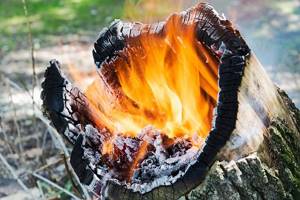
Get rid of an old stump using saltpeter.
As soon as spring comes, the stump is set on fire - it burns well and burns out completely. This method gets rid of stumps that are located on clay or sandy soil. However, using this method is very dangerous if the soil on the site is peaty.
Using urea to remove a stump
If the wood of a stump is impregnated with urea, it quickly decomposes. The technology is similar to that described above - ammonium nitrate is poured into holes prepared in the stump, filled with water and the stump is covered with cellophane.

Using urea to remove tree stumps.
Urea is considered a good fertilizer, so the remains of the stump do not have to be removed. If you leave the stump underground for several years, fertile soil will appear in this place, on which you can plant a flower garden or plant a vegetable garden.
Choosing the Best Stump Removal Method
All of the methods described above for uprooting stumps are quite effective:
- It is convenient to use mechanical stump uprooting when clearing a site for the construction of buildings or when redeveloping a site.
- It is convenient to use chemicals to uproot stumps in areas where objects are located. This method is not expensive or time-consuming.
- When planning to lay out a bed stump at the site, it is better to uproot the stump manually or using a shredder: a crusher or a forestry cutter.
If you want, you can grow edible mushrooms on the stump.
The stump is destroyed by nature itself
Man today has learned to use the natural processes of self-regulation to his advantage. Under natural conditions they take a long time, so catalysts are needed for use in modern life. They become artificially created favorable conditions for wood decomposition.
We use moss
Moisture is detrimental to any type of wood. On swampy soil it is very difficult to find a healthy tree - mostly there are only rotten trees. And this is exactly the state we need to achieve. Any type of moss grows well on damp surfaces. By tightening the surface of the stump, the plant begins to feed on the wood and further accelerate the decomposition process.
After a few seasons, only dust will remain from the stump, which will not be difficult to remove. And all this time the area will be decorated with a bright green moss cap. Effective and aesthetically pleasing.
We use mushrooms
This method is quite young and relatively recently began to be used in Russia. Mycelium of various fungi is applied to unwanted stumps in the area. You can plant oyster mushrooms, honey mushrooms and other woody types of mushrooms. Shed it thoroughly and create a greenhouse effect - wrap it in film for a while, but do not overheat.

When the mushrooms sprout, they will take nutrients directly from the stump, thereby destroying it. After a few seasons, you will get the long-awaited result - a destroyed stump. And before that, your own mushroom harvest right on the site.
We use ants
The stump must be thoroughly shed and then wrapped in dark polyethylene. Don't disturb him for some time. The favorable conditions created will attract various insects, including ants. An anthill created right in a stump will very quickly turn the wood into dust.

However, there is one drawback - it may be necessary to fight ants. Therefore, the method should be used only after careful consideration and planning of the site. If there are no residential buildings or recreation areas in this area, but only flowers, flower beds and other vegetation, then an anthill may come in handy. Otherwise, insects will cause a lot of trouble.
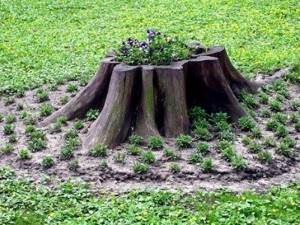
Before you zealously rush to fight stumps and mercilessly uproot them, it is worth taking a critical look at the area. Perhaps the very stump that you want to remove will become a wonderful element of dacha decor, turning into a living flower bed, a natural table, or will become the basis of your garden. Thus, saving you a lot of effort, energy and money, and will also add a unique element to your garden plot.
